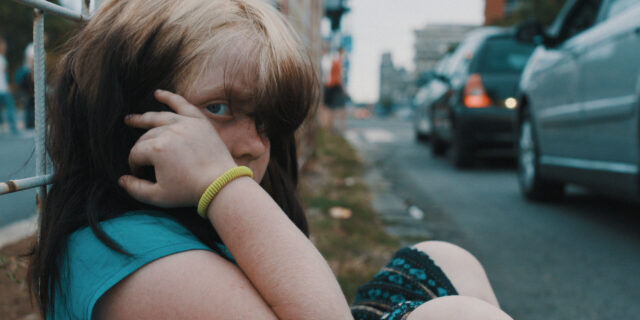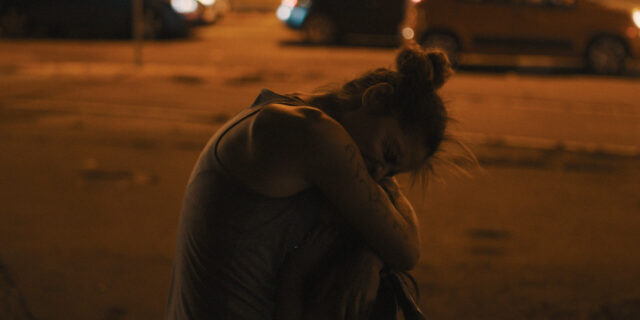
Milica Novakov is determined to make a better life for her family against all odds in Museum of the Revolution
MUSEUM OF THE REVOLUTION (Srđan Keča, 2021)
DCTV’s Firehouse Cinema
87 Lafayette St.
May 19-25
museumoftherevolutionfilm.com
www.dctvny.org
In 1961, Yugoslavia selected a design for the Museum of the Revolution to be built in New Belgrade, honoring the nation’s democratic socialism as it became part of the Non-Aligned Movement. “The purpose of this museum is to safeguard the truth about us,” architect Vjenceslav Richter said at the time. That quote opens Srđan Keča’s strikingly photographed, heart-wrenching Museum of the Revolution, followed by a proverb that proclaims, “The wind got up in the night and took our plans away.” The twenty-year project was shelved halfway through as the country turned to capitalism, leaving behind only the basement level, where unhoused, destitute people sought shelter.
In 2014, the Yugoslav-born writer, director, and professor created a multimedia installation about the would-be museum for the Serbian Pavilion at the Venice Biennale of Architecture. While filming in the abandoned location, he met an old woman named Marija Savič, known as Mara, who lived in the basement, along with a young girl, Milica Novakov, and her mother, Vera. They had formed a kind of three-generation family struggling to survive, mired in seemingly inescapable poverty.
Milica and Vera spend their days in the middle of traffic, cleaning the windshields of the very few drivers who let them. In the snow, Milica tries to make a heart but continually fails; a few moments later she is running around with Mara, laughing and smiling as young girls should.

Vera Novakov is running out of hope in Srđan Keča’s Museum of the Revolution
Museum of the Revolution begins with more than twelve dialogue-free minutes as Keča, who also served as cinematographer and edited the film with Hrvoslava Brkušić, shifts from archival footage depicting the hope of the new Yugoslavia to the dank, filthy, dungeonlike area where that promise disappeared. It’s an almost impossibly dark space, a small fire burning for heat, outside light visible through a path strewn with garbage, blocking their way to a better life.
Mother and daughter head into the city so Vera can send money to her husband, who is in prison. At one point they pass by a school where children can be heard playing, but that kind of education is not available to Milica, who is dedicated to helping her mother any way she can so they can get out of this tragic situation.
Vera holds back tears so Milica won’t see. They bathe and wash their clothes in a dirty lake. Vera picks lice out of Milica’s hair. Mara tells Vera the story of her own daughter, Dragana, whom she gave up as child. Mara wanted to reconnect and told Dragana, “If I couldn’t raise you when you were a child, at least we can be together when I die,” but Dragana rejected her.
As corporate towers and luxury residences under construction rise around them, it’s clear they have nowhere to go. Vera’s desperation grows, but Milica still believes that they will soon have a normal existence, in which her mother has a job and picks her up from school every afternoon, going together to a home with its own bathroom.
Museum of the Revolution features gorgeously photographed extended shots with natural sound — wind, rain, traffic — while other scenes are underscored by Hrvoje Nikšić’s gentle, cautionary music. It’s a painfully intimate film; Milica and Vera pay no attention to the camera, just going about their days and nights, neither seeking sympathy nor railing against the system.
Keča’s debut feature after such shorter works as A Letter to Dad and Mirage, it’s a haunting tale filmed like a fictional narrative; I had to keep reminding myself that it’s a documentary. In fact, the credits identify the three protagonists as if they are portraying characters, not themselves. It could be anyone’s story, in any country, but it’s all too true.
The final shot of Milica is unforgettable — a stark comparison to Antoine Doinel (Jean-Pierre Léaud) on the beach at the end of François Truffaut’s The 400 Blows — followed by several minutes of eerie silence as a solitary light glows in the darkness.
Museum of the Revolution runs May 19-25 at DCTV’s Firehouse Cinema, with Q&As with Keča on May 19 at 7:00 with DCTV public programs director Dara Messinger, May 20 at 8:30 with documentarian Pacho Velez (The Reagan Show, Manakamana), and May 21 at 12:30 with digital director and film critic Violet Lucca.